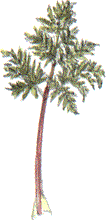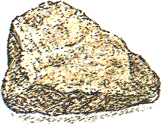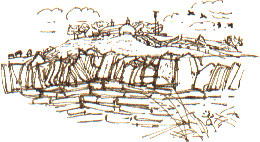 |
Spring LeavesSunday, 18th February 2001, West Yorkshire |
![]()
![]()
![]()
![]()
![]()
![]() This Month
Rocks
History
Workshop
Links
Home Page
This Month
Rocks
History
Workshop
Links
Home Page
![]()
Creeping Buttercup (title sketch, above) has spread over waste ground alongside the pub's children's play area. There are no flowers as yet, but it is easy to distinguish creeping buttercup from the leaves. The central division has a short stem, unlike the meadow buttercup leaf, which is typically shaped more like an outspread hand.
 The new leaves of Cow Parsley (left) sprouting nearby, resemble those of the kitchen herb, but it is more closely related to chervil. Although the fresh leaves are mildly aromatic and can be added to omelette it is probably wiser to avoid using this plant altogether, because of the danger of confusing it with its deadly poisonous relatives.
The new leaves of Cow Parsley (left) sprouting nearby, resemble those of the kitchen herb, but it is more closely related to chervil. Although the fresh leaves are mildly aromatic and can be added to omelette it is probably wiser to avoid using this plant altogether, because of the danger of confusing it with its deadly poisonous relatives. Dock (right) has a better reputation and has long been the traditional antidote to nettle stings. This leaf has pale orange spots outlined in dull purple. I'm pretty sure these are the marks caused by rust fungus.
Dock (right) has a better reputation and has long been the traditional antidote to nettle stings. This leaf has pale orange spots outlined in dull purple. I'm pretty sure these are the marks caused by rust fungus.Sandstone
 A few fragments of rock lie at the edge of the tarmac. This local sandstone was laid down 300 million years ago, at a time when a range of mountains were being rapidly eroded to the north. Rivers deposited vast quantities of sand over what would one day be the West Riding of Yorkshire, giving it a proverbially gritty character from an early age. Like most sandstone, it consists mainly of tough glassy quartz crystals, but it also contains fleshy crystals of feldspar, which, in the rough and tumble of erosion, tend to break down fairly quickly to form clay. Deposition must have occurred fairly rapidly after erosion.
A few fragments of rock lie at the edge of the tarmac. This local sandstone was laid down 300 million years ago, at a time when a range of mountains were being rapidly eroded to the north. Rivers deposited vast quantities of sand over what would one day be the West Riding of Yorkshire, giving it a proverbially gritty character from an early age. Like most sandstone, it consists mainly of tough glassy quartz crystals, but it also contains fleshy crystals of feldspar, which, in the rough and tumble of erosion, tend to break down fairly quickly to form clay. Deposition must have occurred fairly rapidly after erosion.An iron-rich natural cement, limonite, holds the rock together.
 Because it breaks up easily into fairly regular slabs, sandstone has been widely used in drystone walls, such as this one opposite the pub. You can see that even this small fragment has shows a flattish surface (the bedding plane) and that it tends to break at right angles to that surface. The bedding plane is parallel to the river bed in which it was deposited. The joints at right angles may be weaknesses caused by later earth movements or they may result from stresses that were set up in the rock at the time that it formed, stresses caused, for instance, by shrinkage.
Because it breaks up easily into fairly regular slabs, sandstone has been widely used in drystone walls, such as this one opposite the pub. You can see that even this small fragment has shows a flattish surface (the bedding plane) and that it tends to break at right angles to that surface. The bedding plane is parallel to the river bed in which it was deposited. The joints at right angles may be weaknesses caused by later earth movements or they may result from stresses that were set up in the rock at the time that it formed, stresses caused, for instance, by shrinkage.
![]()
Richard Bell,
wildlife illustrator
E-mail; 'richard@willowisland.co.uk'
![]() Next page
Previous page
This day last year
This month
Nature Diary
Home Page
Next page
Previous page
This day last year
This month
Nature Diary
Home Page
![]()